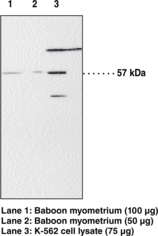服务热线
021-60498804
产品中心
/ Products Classification 点击展开+
| Cat. Number | 702170913710153 |
||||||||||||||||||||||||||||
| Chemical Name | PPARα Polyclonal Antibody |
||||||||||||||||||||||||||||
| References |
Show all 6Hide all but first 3 Background ReadingDevchand, P.R., Keller, H., Peters, J.M., et al. The PPARα- Kroetz, D.L., Yook, P., Costet, P., et al. Peroxisome proliferator- Forman, B.M., Chen, J., and Evans, R.M. Hypolipidemic drugs, polyunsaturated fatty acids, and eicosanoids are ligands for peroxisome proliferator- Mukherjee, R., Jow, L., Noonan, D., et al. Human and rat peroxisome proliferator activated receptors (PPARs) demonstrate similar tissue distribution but different responsiveness to PPAR activators. J Steroid Biochem Mol Biol 51 157-166 (1994). Martin, G., Schoonjans, K., Lefevbre, A., et al. Coordinate regulation of the expression of the fatty acid transport protein and acyl- Latruffe, N., and Vamecq, J. Peroxisome proliferators and peroxisome proliferator activated receptors (PPARs) as regulators of lipid metabolism. Biochimie 79 81-94 (1997). Sher, T., Yi, H., McBride, O.W., et al. cDNA cloning, chromosomal mapping, and functional characterization of the human peroxisome proliferator activated receptor. Biochemistry 32 5598-5604 (1993). Gearing, K.L., Crickmore, A., and Gustafsson, J. Structure of the mouse peroxisome proliferator activated receptor a gene. Biochem Biophys Res Commun 199 255-263 (1994). Lemberger, T., Desvergne, B., and Wahli, W. Peroxisome proliferator- Lehmann, J.M., Lenhard, J.M., Oliver, B.B., et al. Peroxisome proliferator- Show all 10Hide all but first 3
DescriptionAntigen:human, mouse, and rat amino acids 22- 1Latruffe, N., and Vamecq, J. Peroxisome proliferators and peroxisome proliferator activated receptors (PPARs) as regulators of lipid metabolism. Biochimie 79 81-94 (1997). 2Lemberger, T., Desvergne, B., and Wahli, W. Peroxisome proliferator- 3Devchand, P.R., Keller, H., Peters, J.M., et al. The PPARα- 4Lehmann, J.M., Lenhard, J.M., Oliver, B.B., et al. Peroxisome proliferator- 5Forman, B.M., Chen, J., and Evans, R.M. Hypolipidemic drugs, polyunsaturated fatty acids, and eicosanoids are ligands for peroxisome proliferator- 6Martin, G., Schoonjans, K., Lefevbre, A., et al. Coordinate regulation of the expression of the fatty acid transport protein and acyl- 7Kroetz, D.L., Yook, P., Costet, P., et al. Peroxisome proliferator- 8Mukherjee, R., Jow, L., Noonan, D., et al. Human and rat peroxisome proliferator activated receptors (PPARs) demonstrate similar tissue distribution but different responsiveness to PPAR activators. J Steroid Biochem Mol Biol 51 157-166 (1994). |
||||||||||||||||||||||||||||





